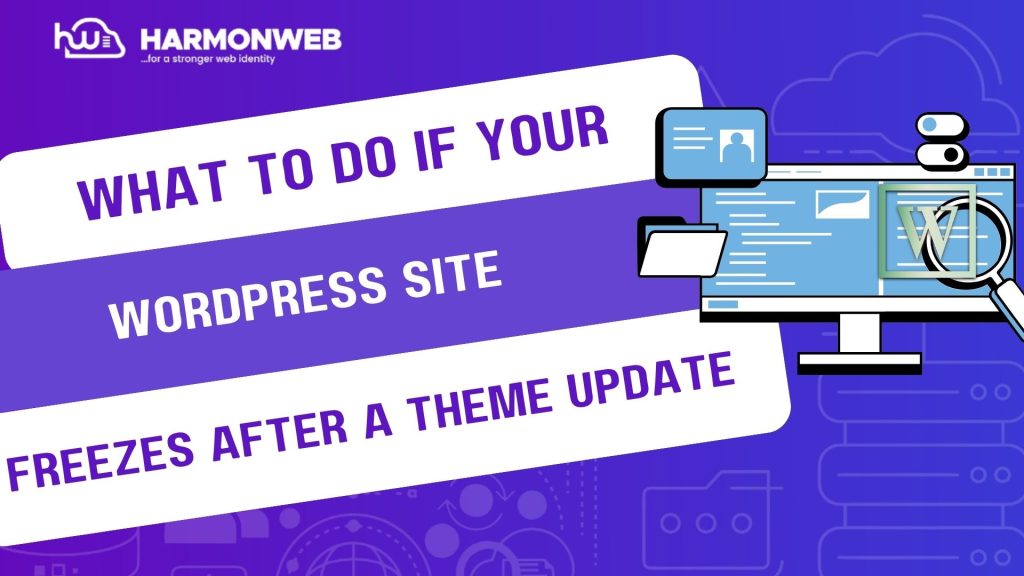Theme updates are meant to improve your WordPress site—fix bugs, patch security holes, and introduce new features. But sometimes, a theme update can have the opposite effect: it freezes your entire website, locking you out of the front end, the admin dashboard, or both.
Whether it is a blank white screen, an error message, or just a slow-loading, unresponsive site, don’t panic. This guide will walk you through the exact steps to restore your site after a theme update gone wrong, even if you can’t access your WordPress dashboard.
Why Your Site Freezes After a Theme Update
Here are some common reasons why a theme update might cause your site to freeze:
• Theme–plugin conflicts: Updated theme code clashes with an active plugin.
• PHP errors: Incompatible functions or outdated code lead to fatal errors.
• Server timeouts: Large or poorly coded themes may overload your server.
• Missing files: The update process was interrupted, leaving essential files out.
• Custom code incompatibility: Manual edits in the old theme version no longer work.
Note: Understanding the cause helps you pick the right fix. Let us explore the solutions.
How to Fix a Frozen WordPress Site After a Theme Update
1. Access Your Site via FTP or File Manager:
If you can not access the dashboard, use an FTP client (like FileZilla) or your hosting panel’s File Manager to manage your site files.
Steps:
• Connect to your server and navigate to:
/wp-content/themes/.
Find your active theme folder (e.g., /astra/, /generatepress/).
Note: This is your recovery point.
2. Rename the Theme Folder:
Temporarily deactivate the broken theme by renaming its folder.
Example: Rename astra to astra_broken
WordPress will automatically revert to a default theme (like twentytwentyfour) if it is installed. This should bring your site back online and give you access to the admin dashboard.
3. Check Error Logs:
Enable debugging to identify what went wrong.
Edit wp-config.php and add:
define( ‘WP_DEBUG’, true );
define( ‘WP_DEBUG_LOG’, true );
define( ‘WP_DEBUG_DISPLAY’, false );
Then check the /wp-content/debug.log file for errors. Look for function errors, missing file notices, or conflicts with plugins.
4. Reinstall the Theme (Clean Version):
If the update failed halfway or corrupted files:
•Download the latest version of the theme from its official source.
• Delete the broken theme folder from /wp-content/themes/.
• Upload the fresh version via FTP or the dashboard.
• Activate the theme and monitor for issues.
If you had custom code in your theme files, restore it from a backup or child theme.
5. Deactivate Plugins Temporarily:
To rule out plugin conflicts:
• Go to /wp-content/ and rename plugins to plugins_backup.
• Reload your site.
•If the theme now works, it was a plugin conflict.
• Rename the folder back and activate plugins one-by-one to identify the culprit.
6. Check PHP Version Compatibility:
Some themes require newer versions of PHP (like PHP 8.0+). If your hosting uses an outdated version, the theme update might break.
What to Do:
• Login to your hosting control panel.
• Look for PHP Manager or Select PHP Version.
• Switch to PHP 8.0 or higher, depending on your theme’s requirements.
• Reload your site.
7. Restore From a Backup (If Needed):
If nothing works and the site is still broken, restore from a recent backup.
Options:
• Hosting control panel backup restore
• WordPress backup plugin (e.g. UpdraftPlus, Jetpack, BlogVault).
• Manual restore via FTP and database tools.
Note: Once restored, test the theme update in a staging site before applying it again.
Pro Tips to Avoid Future Theme Update Freezes
• Always back up your site before updating themes or plugins
• Use a staging site to test updates.
• Keep plugins and WordPress core updated to avoid compatibility issues.
• Use a child theme for customizations to avoid overwriting during updates.
• Read the changelog and developer notes before applying major theme updates.
Conclusion
A theme update causing your site to freeze can feel overwhelming—but it is usually fixable with a few smart steps. From renaming theme folders and checking error logs to reinstalling the theme or adjusting PHP settings, you don’t need to be a developer to get your site running again.
With good backup practices and a staging environment, you can protect your site from future issues and update with confidence.





